JULY 2022

Via Rhona is the French part of EuroVelo 17. EV17 coasts the entire length of the Rhone River, covering about 1,250km of the most varied landscapes in 2 countries (Switzerland and France). It starts in the Swiss Alpine village of Andermatt (1,430m), that is 20km before the Rhone Glacier from which the homonymous river originates. Between Andermatt and the Rhone Glacier the road winds through a series of hairpin bends that lead up to the Furka Pass at 2,430m.
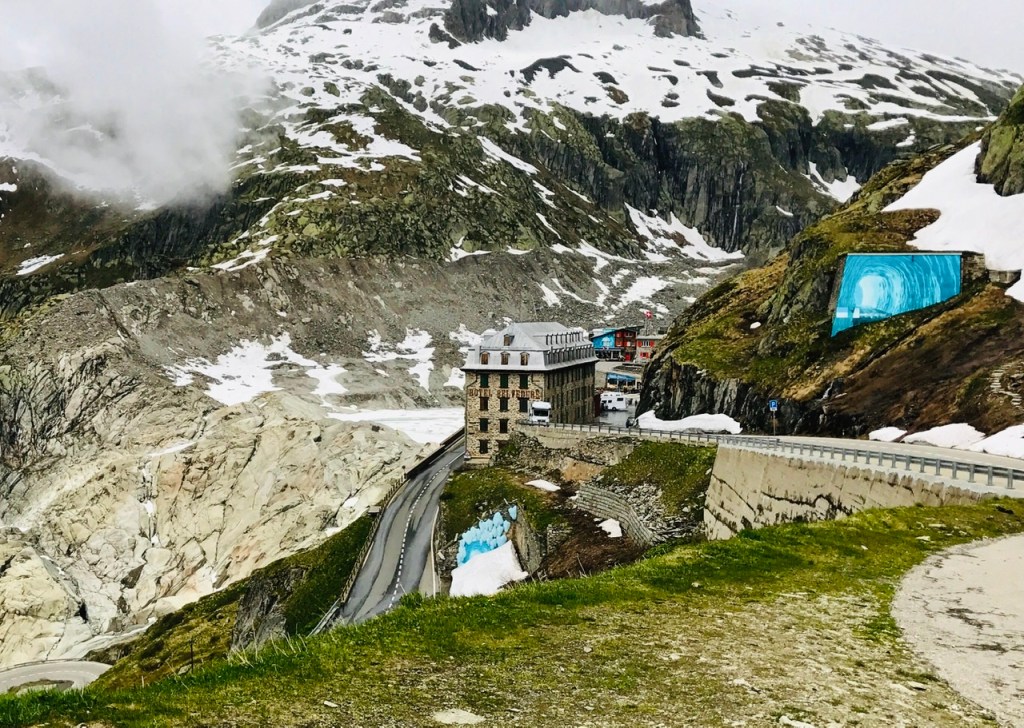
From the Furka Pass, the road descends into the Rhone valley through lush forests until reaching the narrow valley floor shouldered by the snow-capped Alps and then the Rhone delta on Lake Geneva (Lac Leman in French). Here, the road continues along the northern shores of the lake and through the Swiss landmarks of Chillon Castel, Montreux, Lavaux Vineyards, Lausanne, and finally Geneva, where the waters from the lake enter once again the Rhone river towards the Mediterranean Sea. This Swiss part, from Andermatt to the Swiss-French border in Geneva is also called Route 1 in Switzerland (or Rhone Route) and runs for 350km with 3,700m elevation.
In France, Eurovelo 17 is known as Via Rhona, and runs for an additional 800km until the beaches of Camargue, south of Arles. This French section, although much longer, is basically flat and much easier to bike even for families (indeed, even if we have heavy e-bikes we used the engine quite sparingly).

In contrast to the spectacular Alpine landscape of Switzerland, the French section runs through cities, towns and villages immerse in Roman vestiges or medieval history (Lyons, Vienne, Orange, Avignon, Arles just to mention the most famous ones). But the main staple of this route are the variety of suspension bridges that we cross along the Rhone, mostly built in the mid-19th century.
Before starting the description of this tour I want to get some important warnings out there: 1) from Vienne going south there is often a strong wind (Mistral) blowing in the direction of the Mediterranean Sea. Hence the preferred direction of travel is southbound . 2) The best part to do with children (calmer, more separated cycloroutes, more nature immersion) is from Vienne to the sea (an absolute veto is the segment from Lyon to Vienne, see Day-3 further below)
The ViaRhona starts officially in Seyssel, which can be reached via one of the rare TER trains from Geneva . However, for those wanting to link the 2 countries by bike there is a liaison route from Geneva to Seyssel, but it is more challenging in elevation and with more traffic.
*-*-*-*-*-*-*-*-*-*-*-*-*-*
And so we start our 7 days adventure biking the upper Via Rhona from Seyssel to Avignon for about 480km.

*-*-*-*-*-*-*-*-*-*-*-*-*-*
DAY-1; Seyssel ->Les Avenières (67km, 200m^)

Thankfully we arrived the night before in Seyssel.
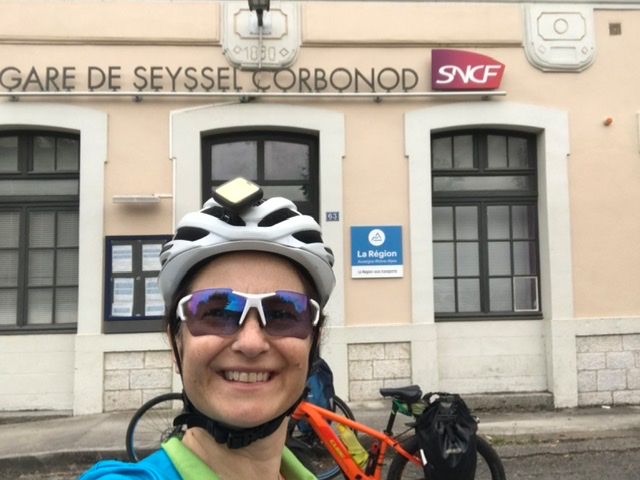
This allowed for a tour of the village (though no major sightseeing here), a good night sleep, and an early bike start in the morning to beat the horrendous mid-day heat of this July. An interesting fact about Seyssel though is that it is split between two regions (Ain and Haute Savoie) by the Rhone.
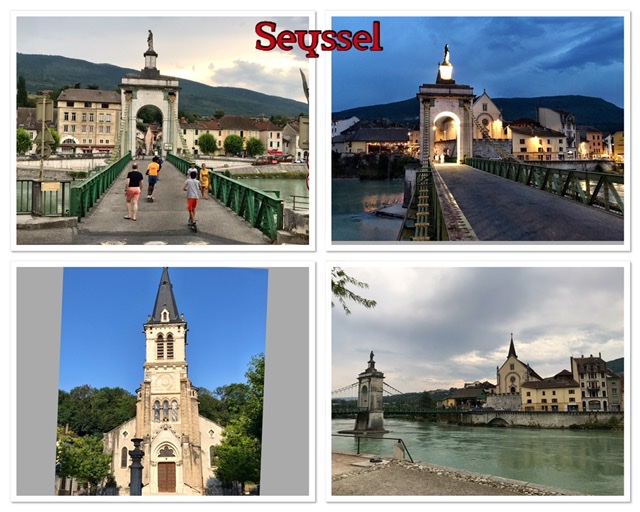
Time 0, km 0: Left Seyssel, the official start of Via Rhona , we enter immediately its Voie Verte (separated cycling corridor typical of France). Initially the directions are not that obvious but further on we find the characteristic green signposts. Needless to say that the Rhone river will accompany us throughout this trip.
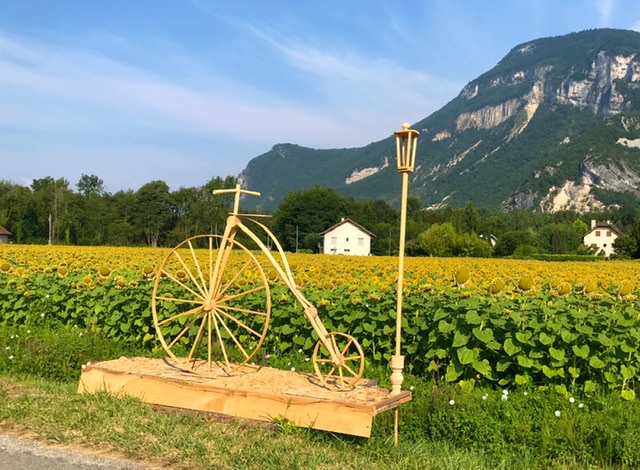

The first charming village is Chanaz, sitting on the canal of Savieres before it enters the Rhone. It has very picturesque medieval buildings, including the “maison de Boigne (17th century) that now houses the Commune. Since we left this morning without food, we stopped here for a simple breakfast in front of the water. This is a very popular cyclist stop and bikers were flooding the area.
But entering the village requires a little detour, crossing the bridge from the opposite side of the channel.
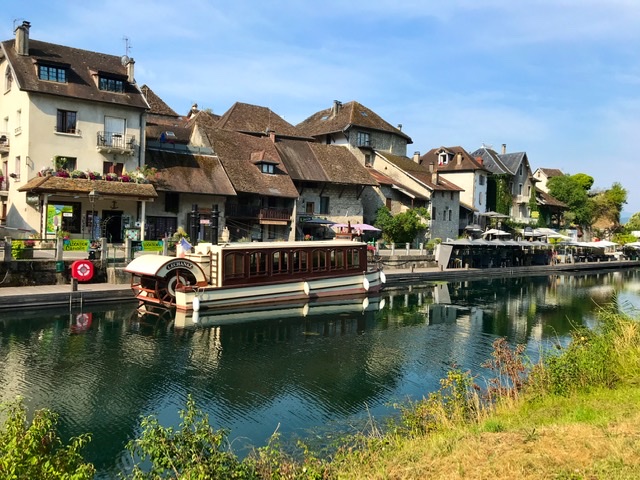

From here the road is sun-exposed for the remainder of the section.

As it was getting really hot we bypassed Belley and its cathedral; it would entails an important detour and we preferred to just move on to our night destination. And this required biking for another 30km down the river, in a very tranquil scenery.
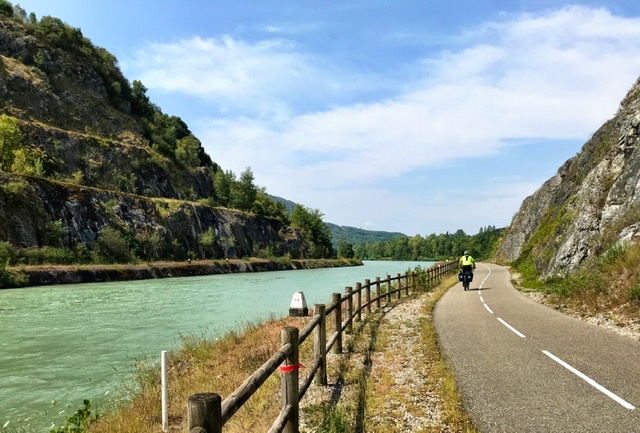

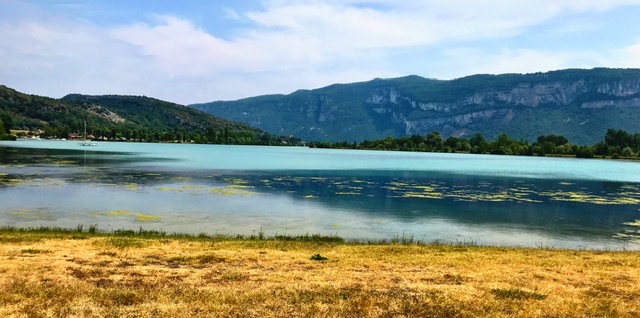
Finally we arrived at our night stay in Les Avenieres (Le domaine du Chaffard). This is a beautiful B&B in a restored farmhouse, with pool and a bucolic surroundings. I highly recommend it! The host provides also a warm dinner if needed while a rich breakfast is included.
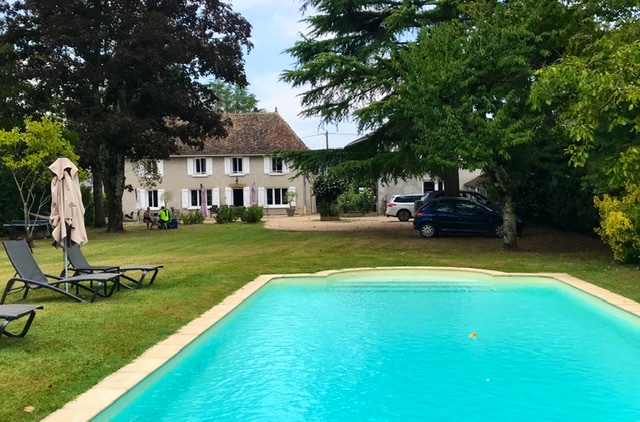
*-*-*-*-*-*-*-*-*-*-*-*-*-*
DAY-2; Les Avenières -> Hières sur Amby (78km, 340m^)
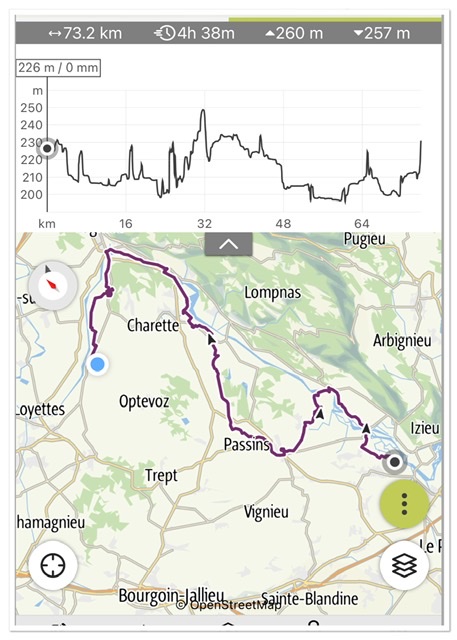
Leaving our B&B, we headed straight in search for the connection to the Via Rhona. But a possibility would have been also to detour to the picturesque multilevel Glandieu waterfall, just an extra 5km from the trail, and well visible from its parking lot. However, in the summer there is little water flowing so it is not the most spectacular time to see them.
So, moving on, about 20km in, we cross the Rhone via the beautiful long suspended bridge at Port-de-Groslée (built in 1912). (Little did we know that this would be only the first of a multitude of beautiful old bridges crossing our path!)
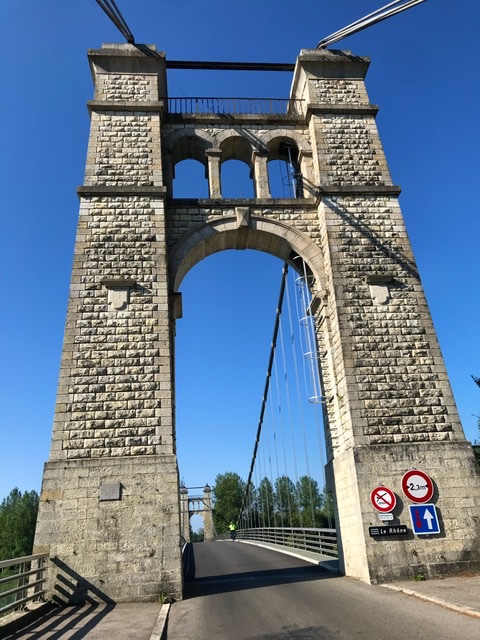

From here the Via Rhona leaves the river and starts a long detour into the countryside. Actually today we saw the river very little.
About midway we arrived to the charming medieval village of Morestel, in full market day (on Sunday). We took the occasion to buy some good food for our meal. Here one could also visit the house of the impressionist painter Ravier, “Maison Ravier”, an 18th century patrician house overlooking the valley, where the painter lived his last years at the end of the 1800s.
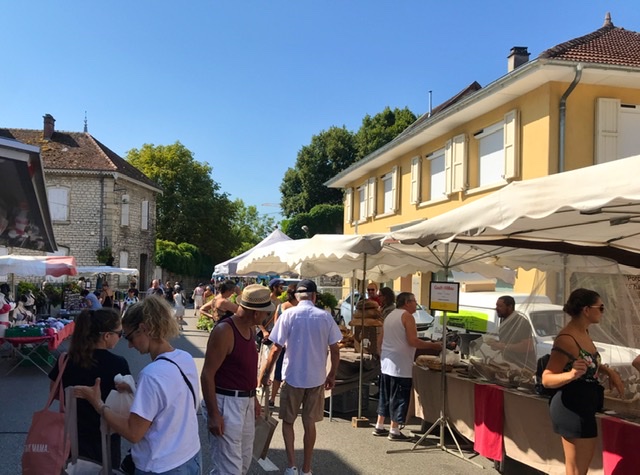
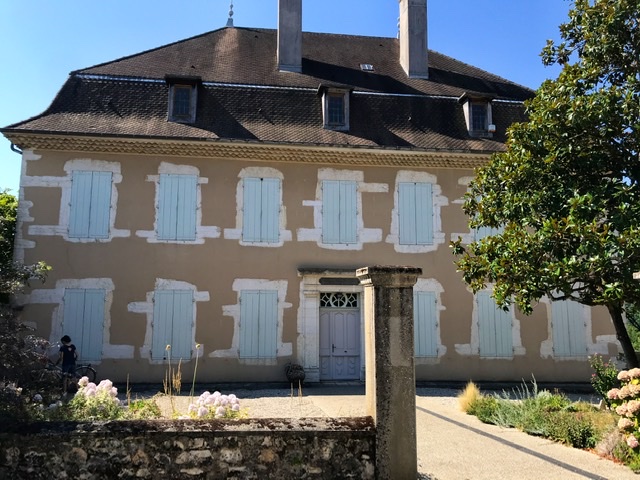
A few km after Morestel we enter the natural area of Arandon with several fishing ponds and picnic areas.
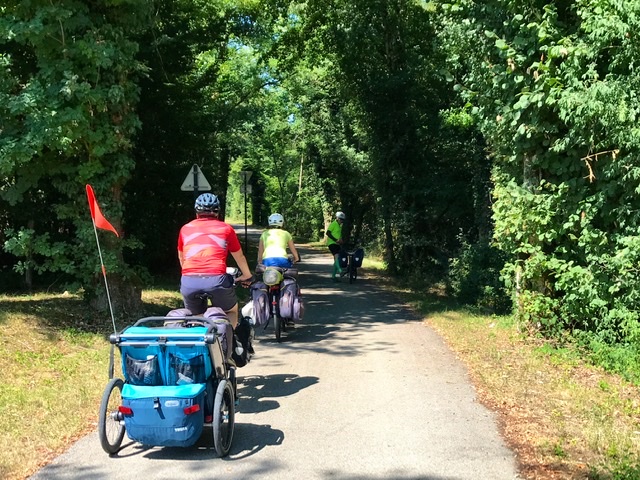
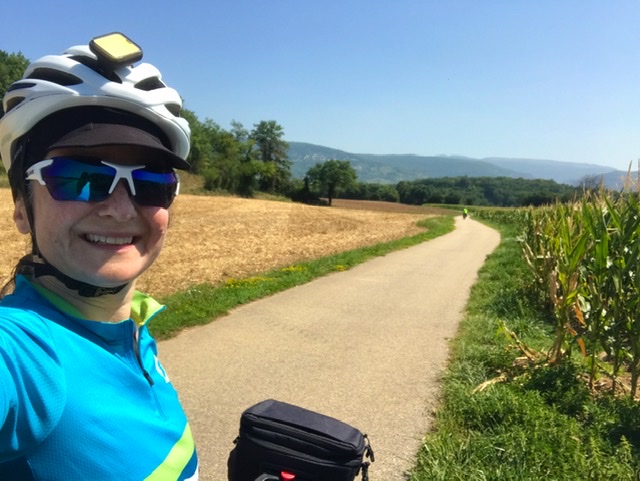

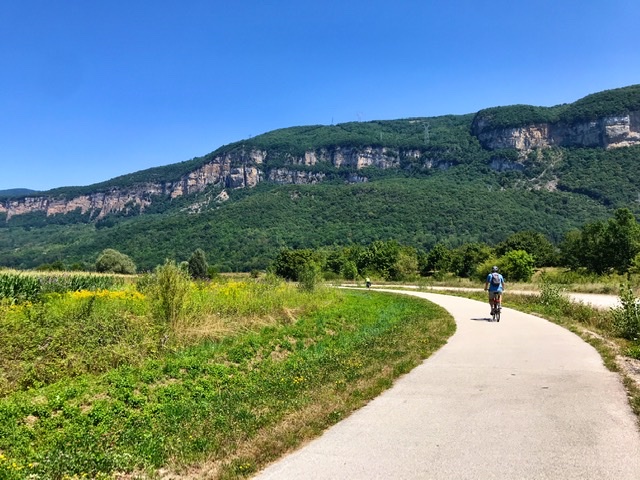
We rejoin the Rhone about 20km after Morestel along a nice stretch of a partially shaded road.

Here, just before Lagnieu, it is impossible to miss, on the opposite bank, the amazing Castle of Vertrieu, an elegant French style 17th century residence with four square towers.
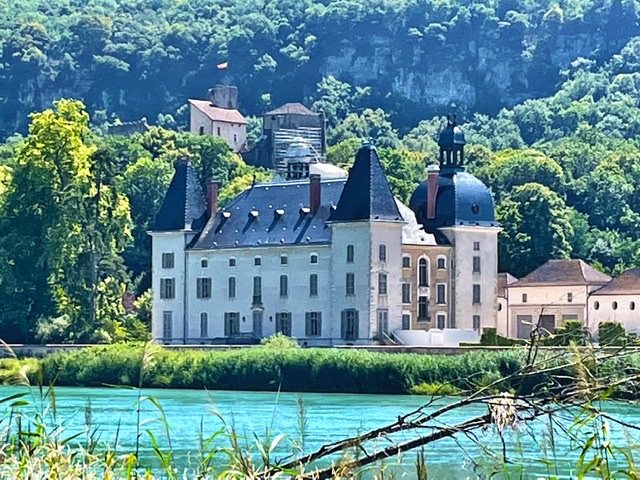
Recrossing at this point the river, we entered the village of Balme-les-Grottes and peeked at the impressive entrance to the caves . This is an amazing natural site to visit (if not too tired like us), especially with children, with its eroded caves and underground lake ( https://www.grotteslabalme.com ).
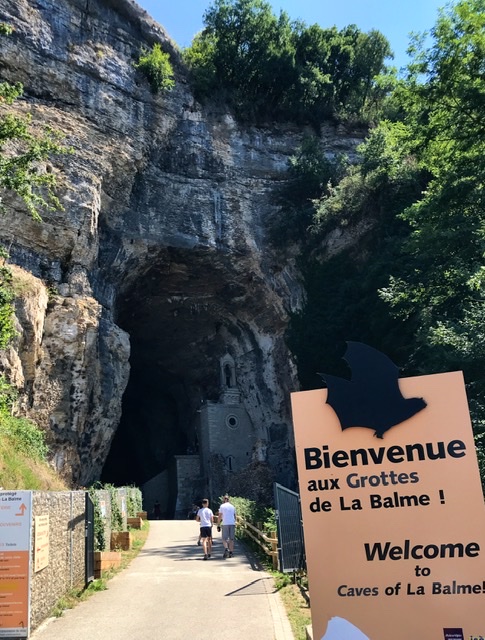
Our night stop is just 8km further at Hyères-sur-Amby, a charming historic village, built in beige stones, under the plateau that once housed ancient hamlets, as shown at the archeological site of Larina .

Unfortunately nearby are also the ominous towers and fumes of the Bugey Nuclear Power Plant…..
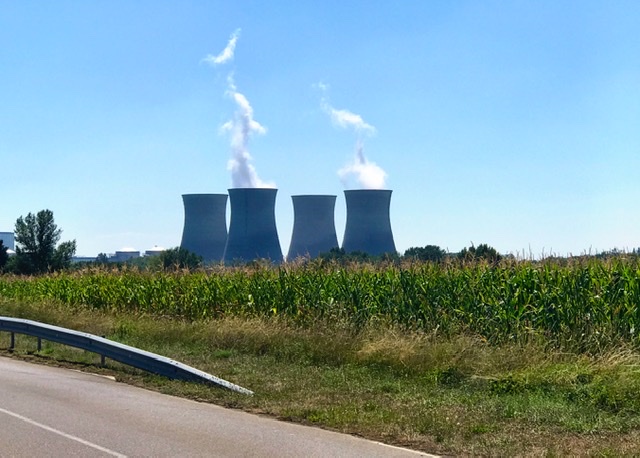
We finally arrived very exhausted at our hotel. Length-wise it was only 10km more than yesterday but we took our time on the trail and so we arrived almost at 4pm, in the peak of the heat. Maybe it was the long biking, or the many little hills (at the end we totaled 330m elevation), or the heat, (or as I discovered much later, the prodromes of a bug), or still the monotony of the landscape……. cornfields and farmlands for the first 20km were beautiful but 70km of it was a bit too much. Also, most of the section is sunexposed so quite unpleasant in the afternoon. But at last we made it!
*-*-*-*-*-*-*-*-*-*-*-*-*-*
DAY-3; Hières sur Amby -> Vienne , via Lyon (98km, 610m^)
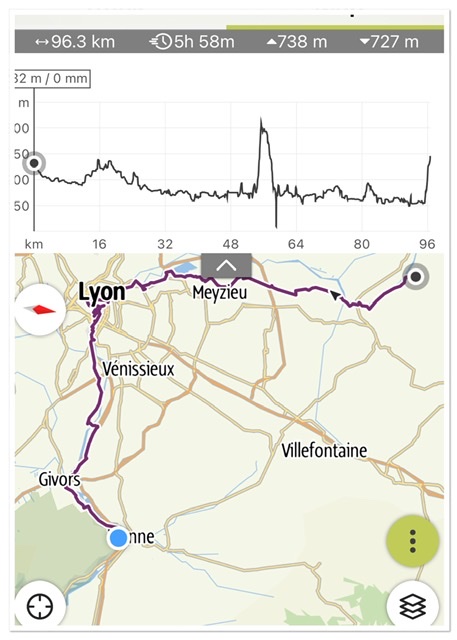
Sorry but this was the worse segment, if it weren’t for Lyon to raise the bar. Indeed I planned a very long day, but that was not the problem. First of all most of the segment is under the sun, and most of the trail shares the road with vehicles (except for the parks and belt around Lyon) . Second, the only place to buy a meal along the way or refill water is Lyon, that is about 50km in (and we had skipped breakfast in order to have an early start!). Third, the first 20km (that is until Jons) are very challenging because the route is not marked and some parts are on natural terrain (so a road biker needs to find alternatives). A good gps of the trail is a must. Thankfully I mapped the Via Rhona with Outdooractive and it was not problem to find my bearings. A nicer landscape opened up near Lyon when we entered the “Grand Parc” of Miribel, one of the largest metropolitan parks in Europe.

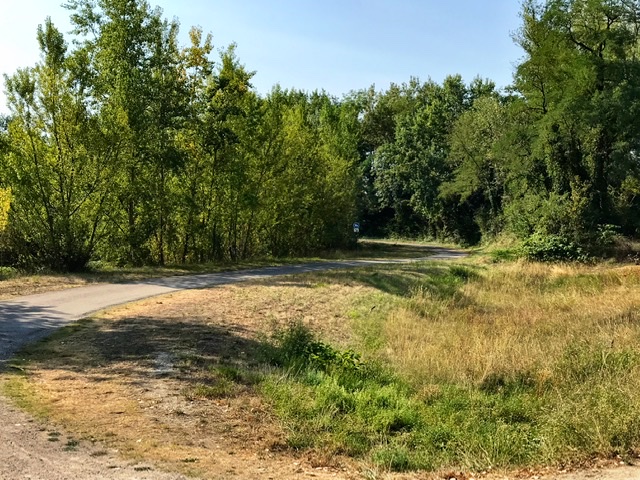

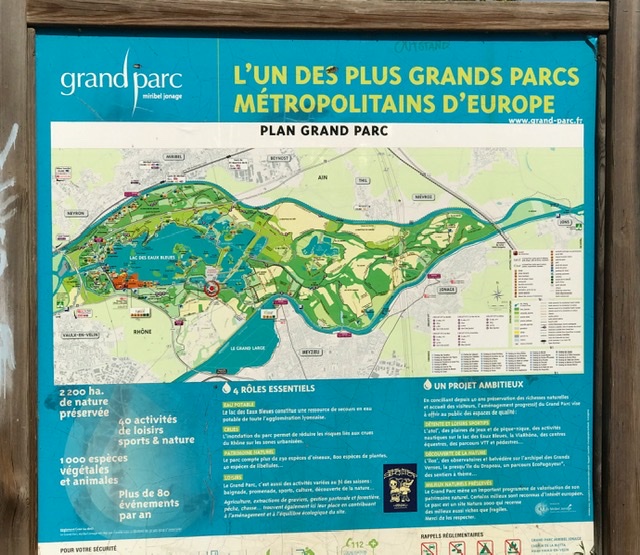
We enter Lyon via a protected cycloroute coasting the river (although noisy) and cross under the hilly quarter of Croix-Rousse via a new under-city tunnel 1.8km long just for the « slow mobility », where bikes and pedestrians move in complete safety.
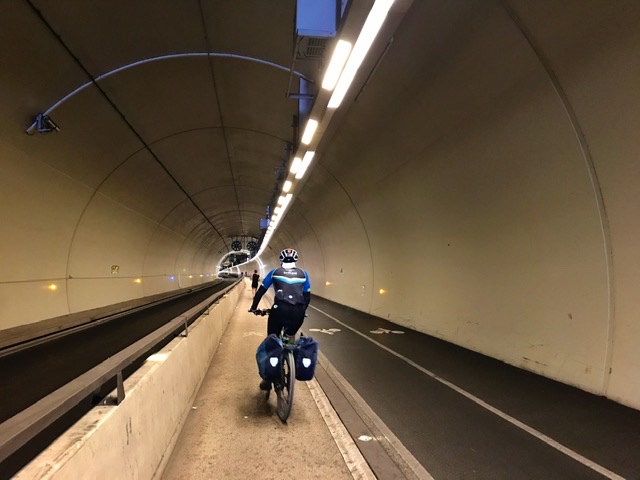
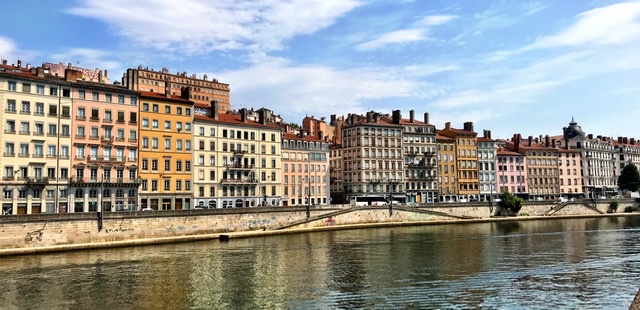
On the other side (on the Saone river), we climb up to the 19th century basilica of Notre Dame de Fourviere. The basilica is inscribed as an UNESCO World Heritage Site. Built at the end of the 1800s, it mixes different architectural styles and is has an incredibly rich decor.
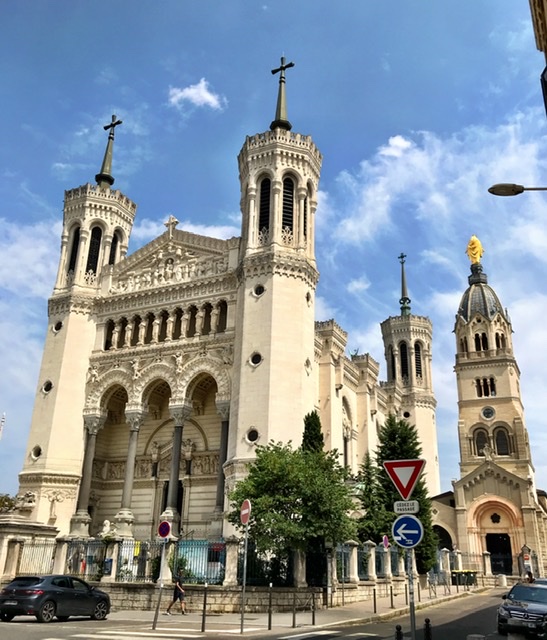

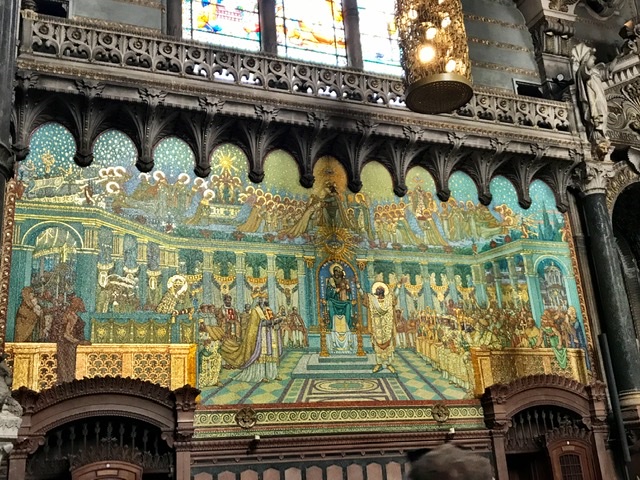

Redescending towards the Rhone, we stop at the charming Vieux Lyon and medieval St. Jean Cathedral with its 14th century astronomical clock. Some of the architectural styles of medieval Lyon are really peculiar and it’s worthy walking looking up.



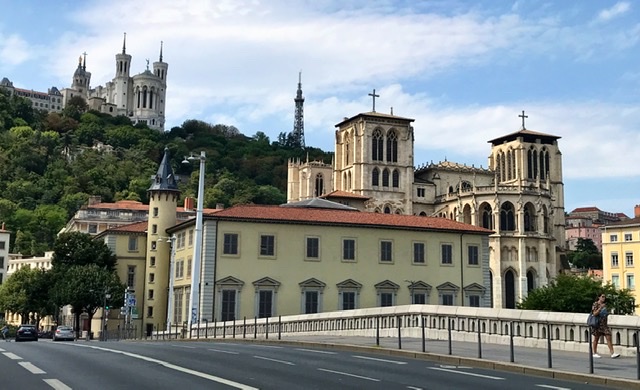
And then before leaving Lyon, one cannot miss a glance at the futuristic cultural center “musée de la Confluence”, best observed from the cyclo-pedestrian bridge in front.

Here one should head straight for the train station! Indeed I strongly discourage anyone who wants to reach Vienne by the still unfinished (mountain)-bike road……And absolutely not with children . Indeed there is a great 19min train connection from Lyon Part-Dieux to Vienne, saving about 35km of nightmare through an industrial and unattractive and dangerous route. And why I strongly discourage it? First, there are 5-10km of an up and down single natural trail accessible only by bikes with thick tires (thankfully I have one). This would be impossible to do with a road bike and definitely not with children. I did not encounter anyone on this trail (again not well marked), and it is very hidden and scary if something happens. Lastly, apart this isolated natural trail, the rest of the paved trail shares the path with busy roads, so quite dangerous to do with children.

At Givors I decided to at least immortalize the only pretty sight after Lyon, that is the old suspended bridge across the river.
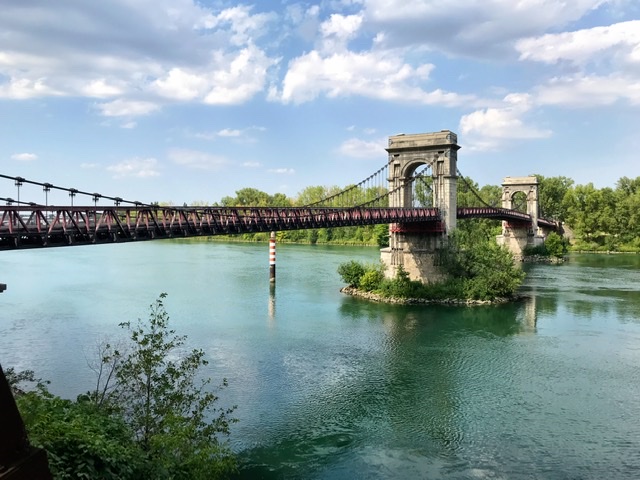
From here, we enter an historic area full of Roman vestiges. Antiquities abound , starting with the remarkable Gallo-Roman Museum of Saint-Romain-en-Gal (it was the commercial and residential area of Vienne) just at Vienne’s entrance ( https://fr.wikipedia.org/wiki/Vienne_(Is%C3%A8re). Next is the amazingly well preserved Roman temple of August and Livie ( https://fr.wikipedia.org/wiki/Temple_d%27Auguste_et_de_Livie ). Built in the 1st-century BC, it is then transformed in a church in the 6th century, by covering the columns and preserving the interior stones.

Nearby is also the 12th century Abbey of Saint-André-le-Bas, and the Saint-Maurice Cathedral (gothic, built in 12th-15th centuries); while a bit uphill is the huge Roman theatre (1st century AD) that could seat up to 12,000 spectators. It is still in use today and it hosts the Jazz festival in the summer.
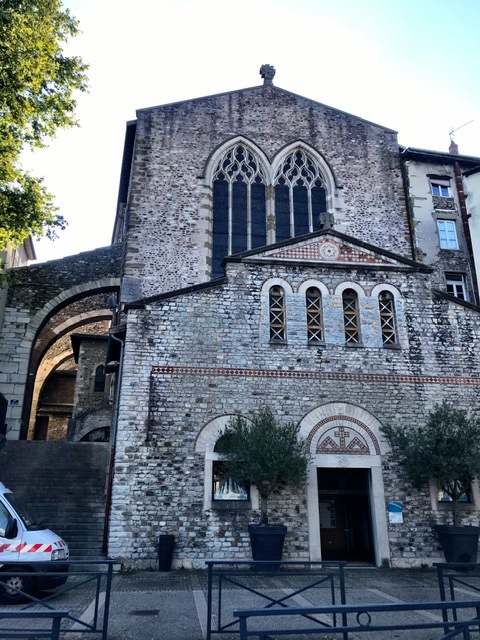
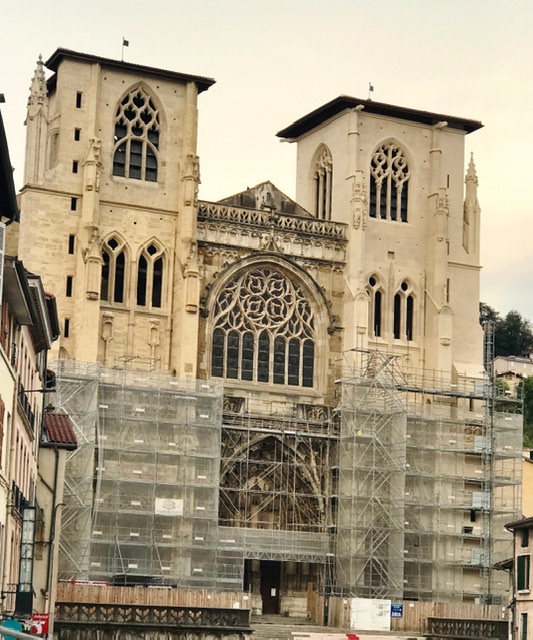
So again, take the train to Vienne, and use the saved time to visit this historic town
We stopped for the night across Vienne, at Sainte-Colombe, in a nice B&B with a great panoramic view on Vienne.
*-*-*-*-*-*-*-*-*-*-*-*-*-*
DAY-4; Vienne ->Tain l’Hermitage (77km, 160m^)

This is the first section almost entirely separated by road and it is basically flat. Very family friendly, passing through several natural reserves in the shade of dense vegetation (but most of the route is sun-exposed ). Indeed, as I mentioned before, if traveling with children one can skip the entire part above Vienne, and start in Vienne (reachable by train) and then bike south (I passed several children with their bike bags :).
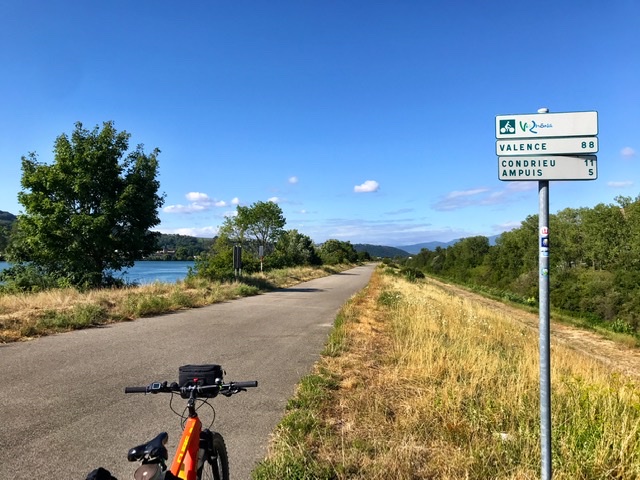
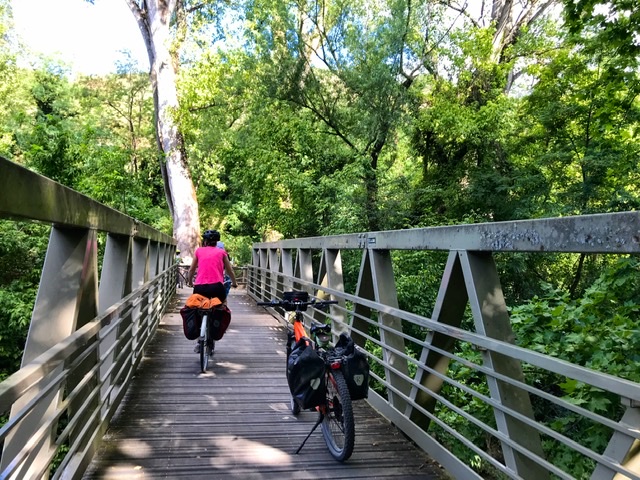

Again, many old bridges deserve a stop for a photo, like the one connecting Andacette-Andance (built by Marc Seguin in 1827). Here we are almost at midway between Geneva and the Mediterranean sea along the Via Rhona. Picnic spots and benches are everywhere on this route, so bring your food to stop at your own convenience.



Arrived at Tournon we are surrounded by vineyards, extending on both sides of the Rhone. Here there is the usual medieval aggregate with old churches and a castle.
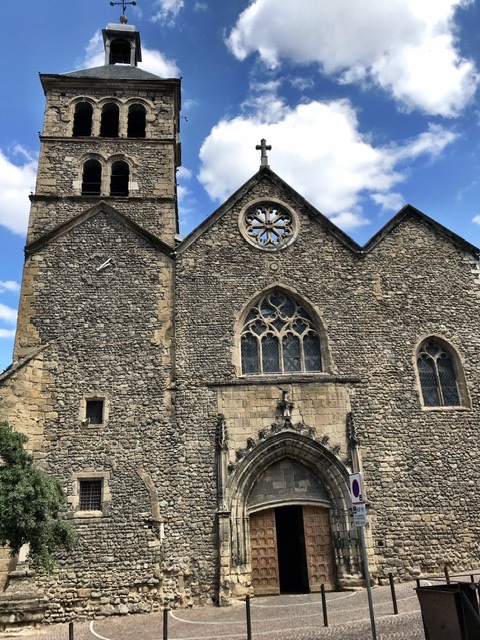
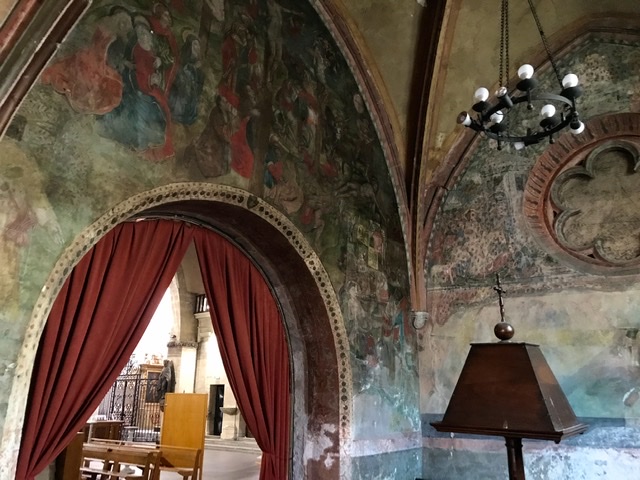
But we immediately crossed the river via an old footbridge with wooden pavement and enter the opposite village of Tain-l’Hermitage, famous for chocolate ( optional visit to la Cité du chocolat Valrhona). This footbridge was built in 1849 by Marc Seguin and his brothers. Seguin indeed invented the wire-cable suspension bridge. Its first worldwide bridge of this type was erected in 1825 just near the actual Tournon bridge, but it was later demolished due to instability. By the end of his life Seguin and brothers built over 180 suspension bridges in France (e.g. the one mentioned before at Andacette or the one farther south at Rochemaure).
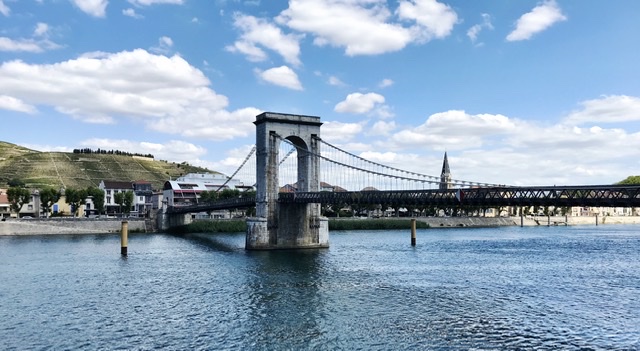
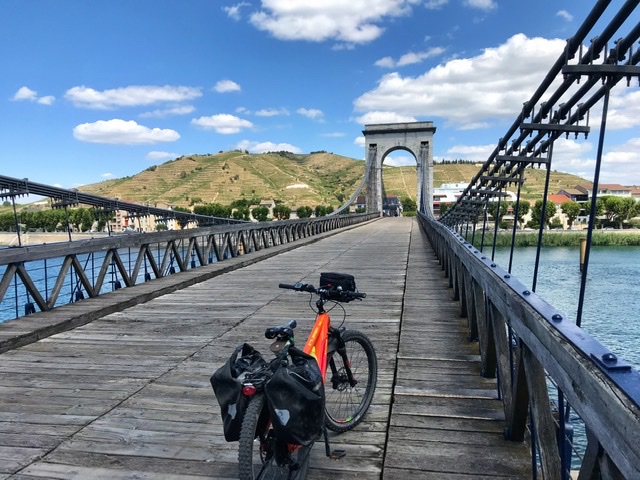
Our Hotel (Les 2 Couteaux) sits right on the Rhone and we had a balcony with a fabulous view on the bridge and opposite town. I highly recommend it!

*-*-*-*-*-*-*-*-*-*-*-*-*-*
DAY-5; Tain l’Hermitage -> Rochemaure (90km, 250m^)

So nice to have the wind behind, especially since I don’t feel too well today. Not sure if it is because of the exercise catching up to me or the air conditioning at night or other issues. Indeed I haven’t been able to have a good night sleep since leaving home.
Anyway, this is a beautiful section with quiet bike-paths similar to yesterday though without natural reserves.
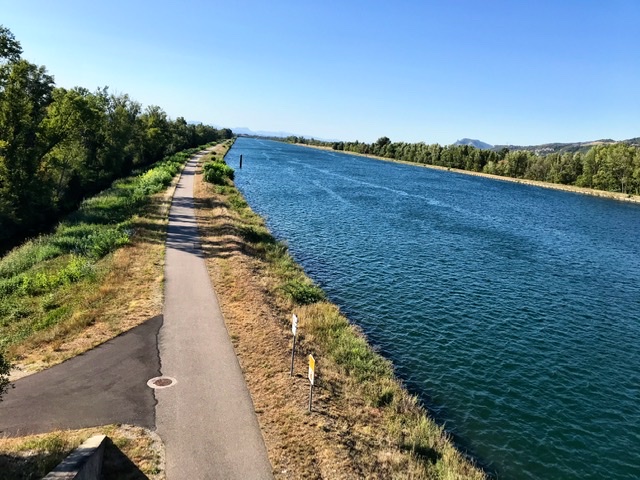
Left Tain, we re-cross the suspended bridge and rejoin the route south in Tournon towards Valence, only 25km away. This is one of the biggest city on the Via Rhona, aside from Lyon and Avignon. If time allows, it deserves a nice tour of its old center and definitely a photo-shoot of the famous kiosk Peynet (built in 1890), which sits conveniently on the bikeroute. Interestingly, these kiosks proliferated in the mid 19th century as a place for popular bands or chorales to exhibit themselves.

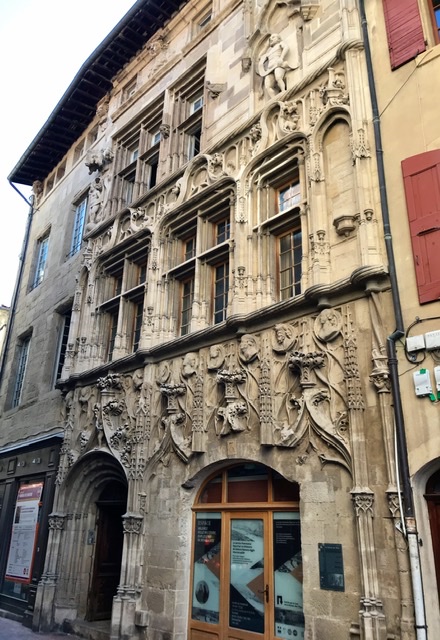


Halfway on this section is La Voulte sur Rhone, with its Renaissance castle seen from afar. Here, we cross another beautiful bridge to the other side of the river.

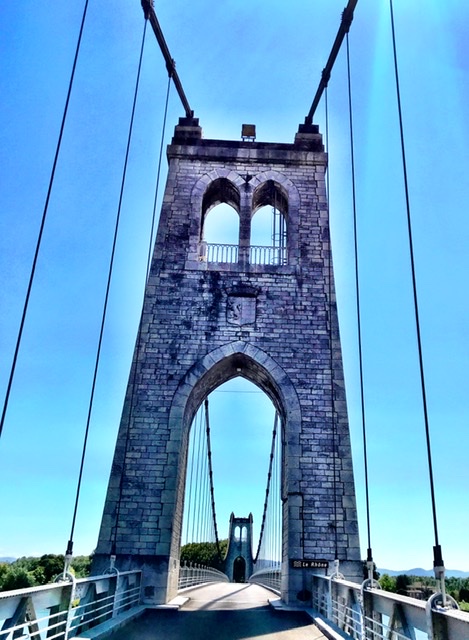


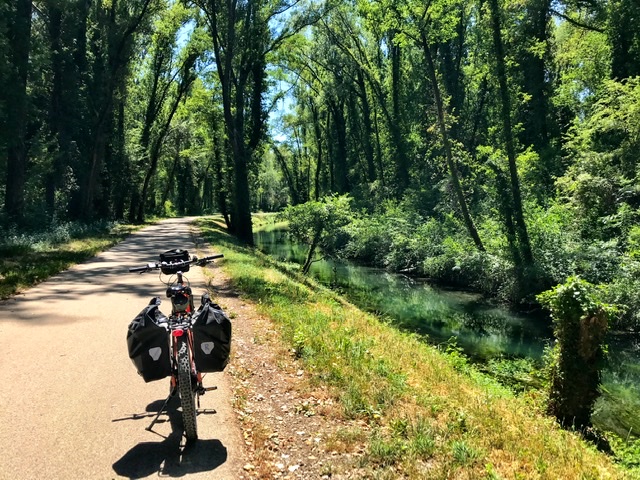


Incredibly, another large nuclear plant station greets us near Cruas. The veloroute passes at a stone throw of the 4 reactors. What catches the eye is the massive mural (titled Le Verseau/Aquarius) on the first tower. This was designed by Jean-Marie Pierret in 1991 and took 9 mountaineers to actually paint it. The painting shows a naked child using a shell to drop water on crystals before it evaporates. It evokes the idea of the cooling mechanism inside the reactor, all the while combining the basic elements of Water and Air.
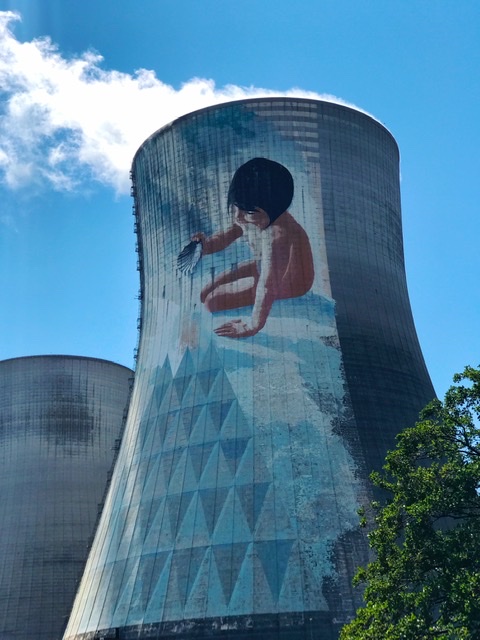
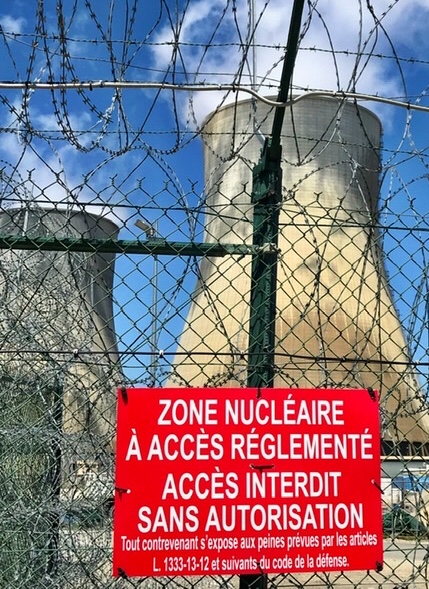
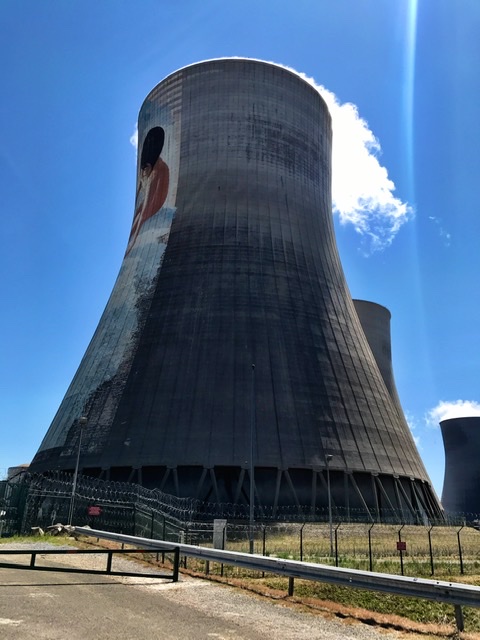
I was so magnetized by this mural and these massive reactors that I completely forgot to visit the picture-perfect medieval village of Cruas and its Abbey (which was a site to absolutely see!).

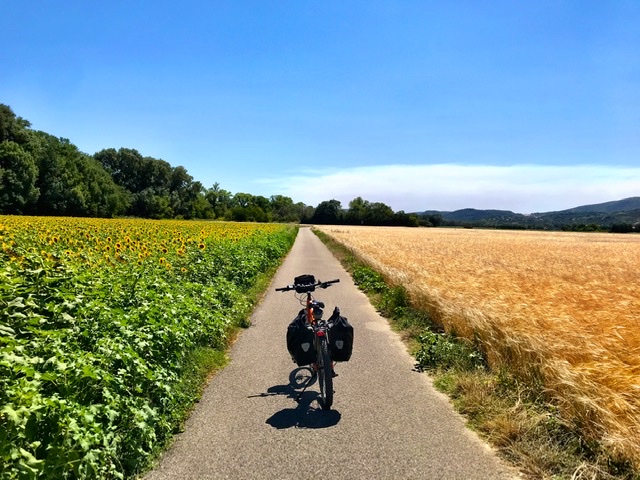
One last stretch brought us to Rochemaure and its old fortress (the ruins of the 12th century castle are quite uphill and we did not go). And to add misery to the end of the biking day, the entire village was under a blackout…… so baggage dropped at the hotel, quick shower taken in the dark, back on the bike for 7km to Monteliar to find a restaurant…….and of course 7km back to Rochemaure in the dark……
*-*-*-*-*-*-*-*-*-*-*-*-*-*
DAY-6; originally planned Rochemaure -> Châteauneuf-du-Pape (82km, 120m^) (modified because of sick day: thus biked 7km Rochemaure-Montelimar, took the train Montelimar-Orange, biked 16km Orange-countryside outside C-d-P)
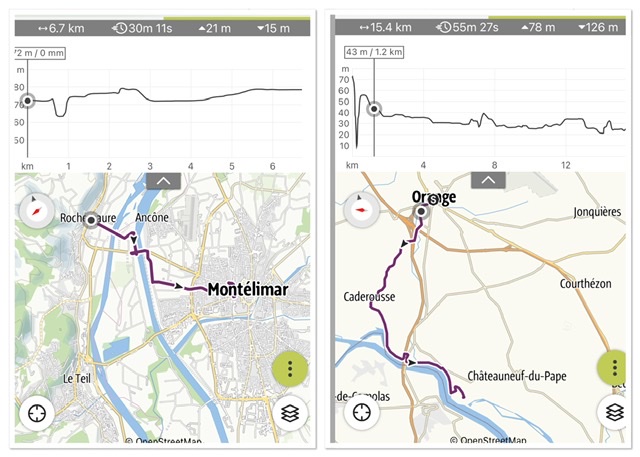

To start the day, at Rochemaure we crossed the river via a 340m long adventurous and picturesque Suspended bridge, slightly swinging from the strong winds (the original pillar structures were built in 1842 by Marc Seguin, while the modern cable suspension and metal passerelle were constructed in 2013). This is definitely the most spectacular river crossing of the entire route!

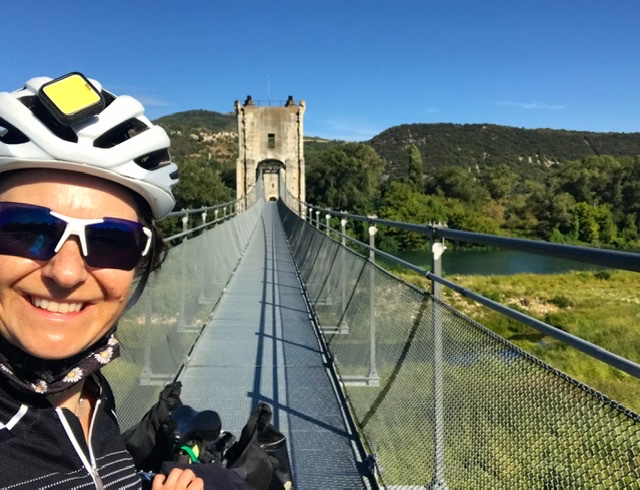
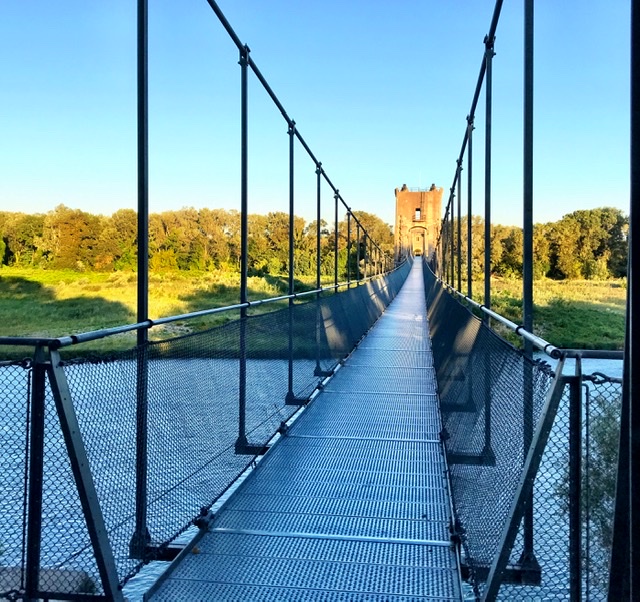
But because of feeling sick, we are skipping most of the biking today, covering Montelimar to Orange by a very comfortable train ride.
PARENTHESIS ON MONTELIMAR TO ORANGE
To make up for the lost sightseeing on Day-6, we came back here on our return trip. Thus, a week later, we are biking from Bollen to Montelimar (45km) in the opposite direction and , as predicted, against a forceful Mistral wind (praise the ebike!).

In the original North-South direction, one should definitely detour 1 km and stop in Viviers to visit its charming medieval center and its must-see Cathedral ( 11th-14th centuries). We were rushing to catch a train and thus we saw the historic villagescape from afar.

Next and not too far are the superb eye-catching vertical cliffs (left bank) of the Drome region near Donzer. Here, it is also impossible to miss a gorgeous long suspension tower bridge (Pont du Robinet, 1847) on the Rhone, with towers of the same color of the cliffs.
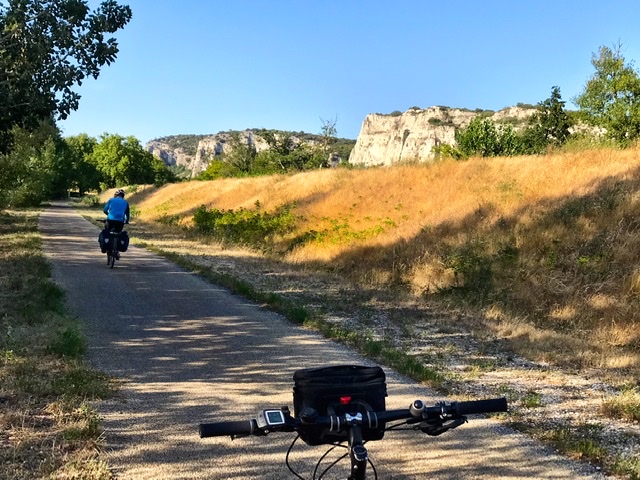

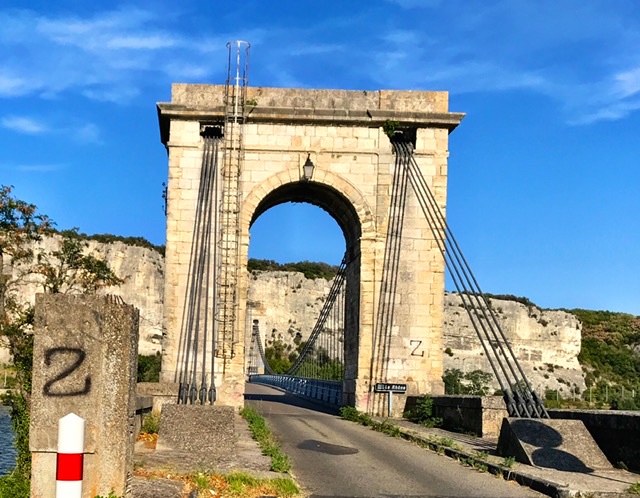
But for a cultural visit one has to wait until Bourg-Saint-Andeol. If one can plan at least two hours stop-over, there is the important Bishops’ Palace (or “Palace of a hundred rooms”) to visit (built between the 15th and 17th century). For those like us passing by, it may not be possible to leave bikes and bags. Careful planning is imperative for this or any other cultural visits ( allotting ample time so not to rush and stress out on vacation……..). Got the hint??
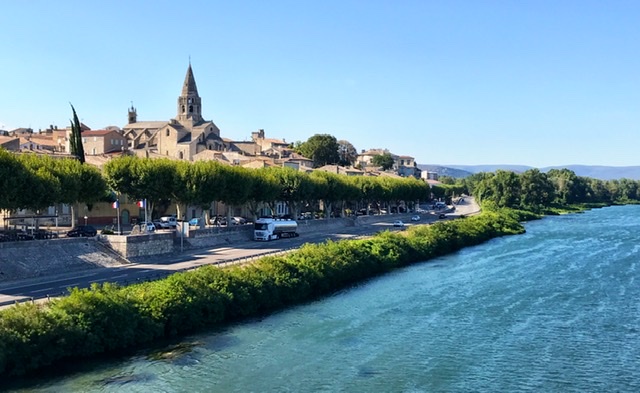
Back-tracking now to our DAY-6 of the southbound tour, the train delivered us in the center of Orange, and so we took the opportunity to do some sightseeing here. And what a fantastic town this is! Full of historic sights and with plenty of small restaurants to stop for a bite. A must see (and to visit if possible to leave the bikes) is the impressive Roman Theatre (built in the 1st century AD), amazingly well preserved with its almost 40m-tall stage wall (I’ve never seen such a preserved stage wall!) .
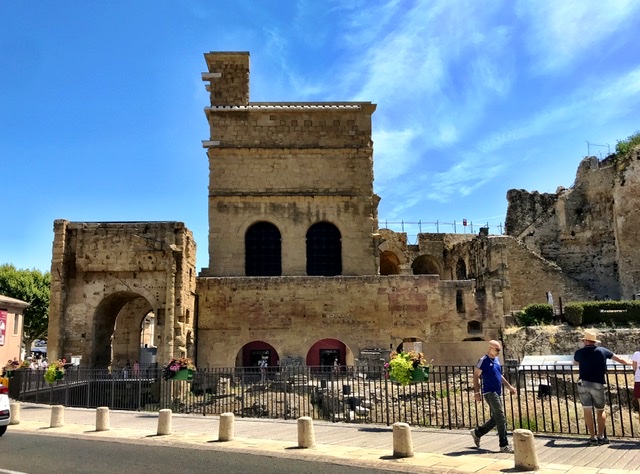

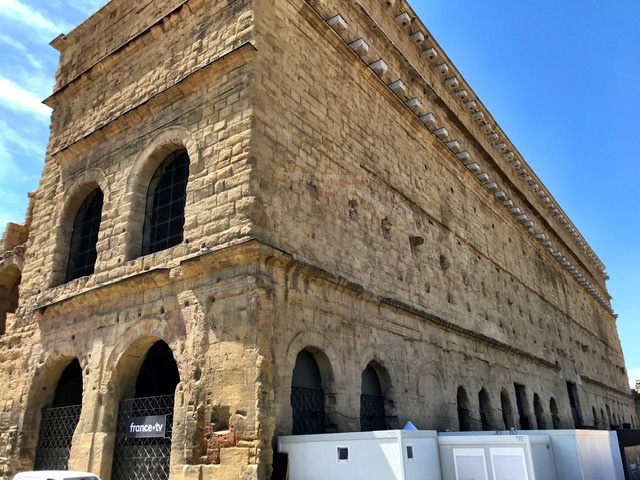
The Arc de Triomphe (1st century) is also important but it is about 1km from the Theater and we did not see it. And then another site would be the 12th-century romanesque Cathedral, which is currently closed for renovation.
From Orange we biked the last 16km towards our B&B on the Rhone, in the countryside surrounding the famous wine-domains of Châteauneuf-du-Pape.



*-*-*-*-*-*-*-*-*-*-*-*
Day-7; Châteauneuf-du-Pape -> Avignon (25km, 40m^)
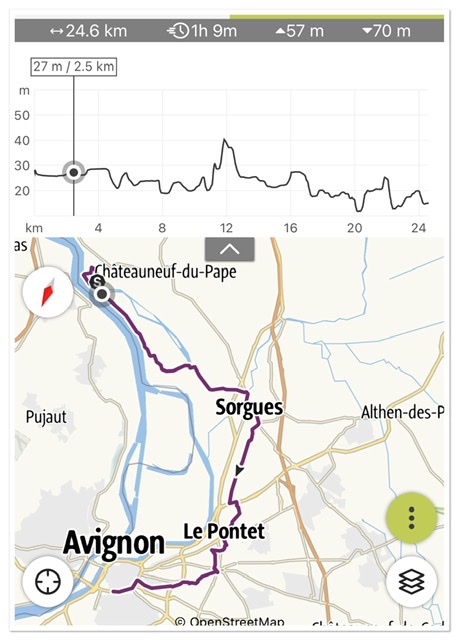
We went to Avignon just to catch our train so with no time to visit it. However most of this route was next to or shared with busy roads so not pretty at all, also passing through mediocre suburban areas.

Going towards the Center Train Station, the only site visible along the cycloroute are the amazing City Walls, erected in the 14th century by Pope Innocent IV. They are still incredibly well preserved!

And we have arrived at the conclusion of this bike trip!
As mentioned before, we had to skipped some parts during day 6. We would have loved to visit for example Châteauneuf-du-Pape. This is supposed to be a nice touristic little village dominated by the ruins of the old Palace but especially by the vineyards. And if you google « Châteauneuf-du-Pape » or things to do there, the only items that pop up are wines and tours of the vineyards! However, it has also a castle built in the 14th century for Pope John XXII, while residing at that time in Avignon.
And lastly, some REFLECTIONS and lessons learned for Multiple-Day Trip and this tour in particular :
- Plan sections with no more than 4h sitting on the bike. Otherwise it becomes too tiring on multi-day trips, and it does not leave space for additional sightseeing (for me it would be around the 60km mark, regardless of elevation). In this trip, I definitely over planned it, with segments of 70-100km, with no additional time to visit villages and towns.
- Unfortunately entering a town/city entails leaving behind any natural surroundings for more industrial/residential areas, often not pretty and often sharing the road with cars. So we need to carefully consider the trade off.
- Specifically for Via Rhona, if one wants to do only part of it, I strongly recommend to start from Vienne and travel south. The cycloroute is much more organized and safer even for families, and the villages and towns a prettier. If wanting to visit Lyon, one can reach it via train, see the city, and then take the next train to Vienne to start the Via Rhona in earnest. Absolutely to avoid by bike is the section Lyon -Vienne, not yet finished and quite dangerous.
Links to other International Multi-Day bike trips:
- Cycling above the Arctic Circle: LOFOTEN – Norway
- FRANCE- Perpignan to Avignon, EV8-Mediterranee à Velo (south) in 8 days (510km)
- FRANCE- Cycling in the Prealps d’Azur -4 Days
- Cycling the Route des Grandes Alpes , France (southern half)
- Cycling the Grande Traversèe du Jura , France
- Cycling in Engadine, Switzerland
- BIKING THROUGH SWITZERLAND (with an electric bike)
Thank you for this. Well done. Will use this excellent information in the next 2-months! You are a trailblazer. Best regards, J
LikeLike
Thanks for your nice comments. Glad to help and have fun!
LikeLike